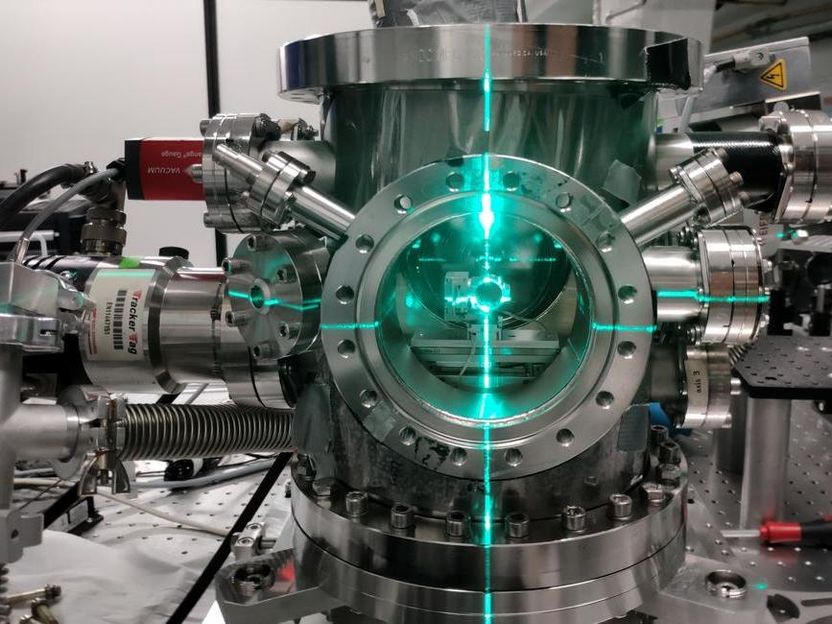Table-top electron camera catches ultrafast dynamics of matter
DESY team demonstrates first Terahertz enhanced electron diffractometer
Scientists at DESY have built a compact electron camera that can capture the inner, ultrafast dynamics of matter. The system shoots short bunches of electrons at a sample to take snapshots of its current inner structure and is the first such electron diffractometer that uses terahertz radiation for pulse compression. The developer team around DESY scientists Dongfang Zhang and Franz Kärtner from the Center for Free-Electron Laser Science CFEL validated their Terahertz-enhanced ultrafast electron diffractometer with the investigation of a silicon sample and present their work in the first issue of the journal Ultrafast Science, a new title in the Science group of scientific journals.

The system fits on a lab table. It is adjusted with the help of an optical laser (green).
DESY, Timm Rohwer

Schematic set-up of the Terahertz Ultrafast Electron Diffractometer.
DESY, Dongfang Zhang


Electron diffraction is one way to investigate the inner structure of matter. However, it does not image the structure directly. Instead, when the electrons hit or traverse a solid sample, they are deflected in a systematic way by the electrons in the solid's inner lattice. From the pattern of this diffraction, recorded on a detector, the internal lattice structure of the solid can be calculated. To detect dynamic changes in this inner structure, short bunches of sufficiently bright electrons have to be used. “The shorter the bunch, the faster the exposure time,” says Zhang, who is now a professor at Shanghai Jiao Tong University. “Typically, ultrafast electron diffraction (UED) uses bunch lengths, or exposure times, of some 100 femtoseconds, which is 0.1 trillionths of a second.”
Such short electron bunches can be routinely produced with high quality by state-of-the-art particle accelerators. However, these machines are often large and bulky, partly due to the radio frequency radiation used to power them, which operates in the Gigahertz band. The wavelength of the radiation sets the size for the whole device. The DESY team is now using Terahertz radiation instead with roughly a hundred times shorter wavelengths. “This basically means, the accelerator components, here a bunch compressor, can be a hundred times smaller, too,” explains Kärtner, who is also a professor and a member of the cluster of excellence “CUI: Advanced Imaging of Matter“ at the University of Hamburg.
For their proof-of-principle study, the scientists fired bunches with roughly 10,000 electrons each at a silicon crystal that was heated by a short laser pulse. The bunches were about 180 femtoseconds long and show clearly how the crystal lattice of the silicon sample quickly expands within a picosecond (trillionths of a second) after the laser hits the crystal. “The behaviour of silicon under these circumstances is very well known, and our measurements fit the expectation perfectly, validating our Terahertz device,” says Zhang. He estimates that in an optimised set-up, the electron bunches can be compressed to significantly less than 100 femtoseconds, allowing even faster snapshots.
On top of its reduced size, the Terahertz electron diffractometer has another advantage that might be even more important to researchers: “Our system is perfectly synchronised, since we are using just one laser for all steps: generating, manipulating, measuring and compressing the electron bunches, producing the Terahertz radiation and even heating the sample,” Kärtner explains. Synchronisation is key in this kind of ultrafast experiments. To monitor the swift structural changes within a sample of matter like silicon, researchers usually repeat the experiment many times while delaying the measuring pulse a little more each time. The more accurate this delay can be adjusted, the better the result. Usually, there needs to be some kind of synchronisation between the exciting laser pulse that starts the experiment and the measuring pulse, in this case the electron bunch. If both, the start of the experiment and the electron bunch and its manipulation are triggered by the same laser, the synchronisation is intrinsically given.
In a next step, the scientists plan to increase the energy of the electrons. Higher energy means the electrons can penetrate thicker samples. The prototype set-up used rather low-energy electrons and the silicon sample had to be sliced down to a thickness of just 35 nanometres (millionths of a millimetre). Adding another acceleration stage could give the electrons enough energy to penetrate 30 times thicker samples with a thickness of up to 1 micrometre (thousandth of a millimetre), as the researchers explain. For even thicker samples, X-rays are normally used. While X-ray diffraction is a well established and hugely successful technique, electrons usually do not damage the sample as quickly as X-rays do. “The energy deposited is much lower when using electrons,“ explains Zhang. This could prove useful when investigating delicate materials.
























































